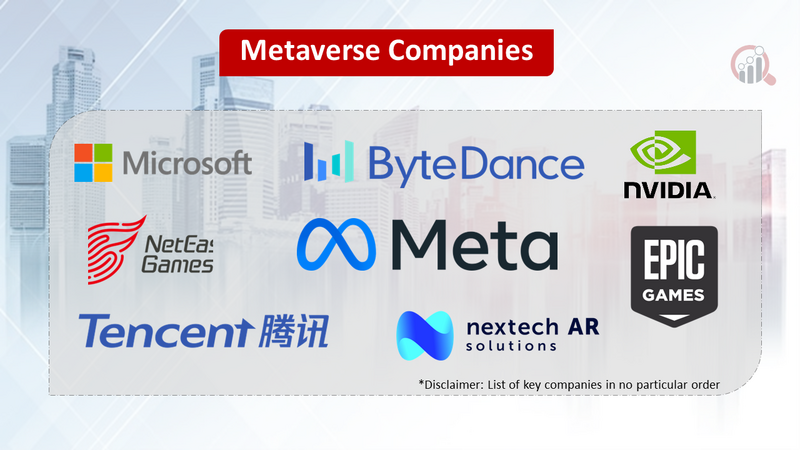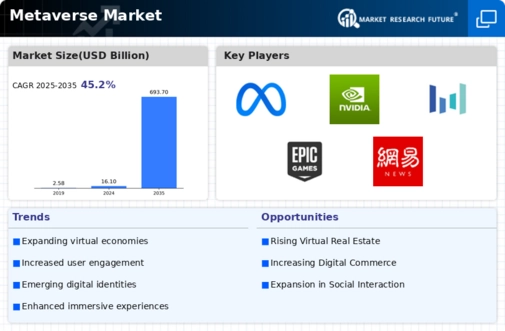Top Industry Leaders in the Metaverse Market

Competitive Landscape of the Metaverse Market: A Comprehensive Overview
The metaverse market is currently witnessing robust growth, attracting both established tech giants and innovative startups. As the boundaries between the physical and digital realms become increasingly blurred, the competition for market dominance is escalating, underscoring the importance of a thorough understanding of the present landscape.
Key Players:
- Meta Platforms Inc.
- Nvidia
- Microsoft Corporation
- Tencent Holdings Ltd.
- Bytedance
- Epic Games
- Netease Inc.
- Roblox Corporation
- Lilith Games
- Nextech AR Solutions Inc.
- Unity Software Inc
- Antier Solutions, among others
Strategies Adopted:
To secure a competitive advantage, companies are deploying diverse strategies, including:
- Establishment of Open Platforms: Numerous enterprises are constructing open platforms to entice developers and cultivate content creation.
- Acquisitions and Partnerships: Strategic acquisitions and partnerships are expediting growth and broadening capabilities.
- Vertical-Specific Focus: Companies are directing their efforts towards specific sectors such as gaming, entertainment, and education, tailoring solutions accordingly.
- Investment in Hardware and Software: The development of cutting-edge hardware like VR headsets and AR glasses, coupled with software platforms enabling immersive experiences.
- Community Building: Engaging with users and fostering a dynamic community is pivotal for user acquisition and retention.
Factors for Market Share Analysis:
Several factors shape the competitive landscape and market share analysis, including:
- Technological Leadership: Companies with advanced technological capabilities and a robust R&D focus enjoy a competitive edge.
- Content and User Base: A comprehensive content library and a sizable user base are crucial for attracting users and cultivating a flourishing metaverse experience.
- Partnerships and Ecosystem Development: Establishing robust partnerships with other companies and organizations can drive innovation and adoption.
- Brand Recognition and Trust: Established brands with a strong reputation benefit from inherent trust and user awareness.
- Financial Resources: Substantial financial resources are essential to invest in research, development, and marketing.
New and Emerging Companies:
Several emerging companies are contributing to the evolving metaverse landscape, introducing novel ideas and innovative solutions. Notable examples include:
- Decentraland: A blockchain-based virtual world empowering users to own land and create personalized experiences.
- The Sandbox: Similar to Decentraland, The Sandbox is a decentralized metaverse platform emphasizing user-generated content and gaming.
- Genies: This startup offers 3D avatars and digital identities applicable across various metaverse platforms.
- Boson Protocol: Facilitating interoperability between diverse metaverse platforms, breaking down barriers and fostering collaboration.
Latest Company Updates:
Nvidia -
In September 2023, Nvidia and OpenUSD released a new update for their series of Into the Omniverse that focuses on how artists, developers and enterprises transform their workflows.
In September 2023, Meta released a generative AI feature to protect the privacy of their users. This includes crucial privacy safeguards with a Generative AI Privacy Guide.
Recent Developments
Photorealistic Avatar Technology
A new form of artificial intelligence is being developed that allows to creation of a face resembled and realistic avatar using the CGI -Computer Generate Imagery. This highly advanced technology leverages computer graphics, 3D motions and other metaverse factors.
3D Reconstruction
Metaverse has always been all about a 3D virtual world, so, it is not surprising that 3D construction forms an important part of making metaverse a reality. One of the primary challenges of the Metaverse is to create an environment that closely represents the real world. Using special 3D cameras and other reconstruction technologies to render realistic 3D images and models of buildings, objects and characteristics, 3D reconstruction helps create realistic and lifelike models for the users. The data collected using 3D cameras and 4K photography are then passed through computers which create life-like stimulations that are to be used in the metaverse.

